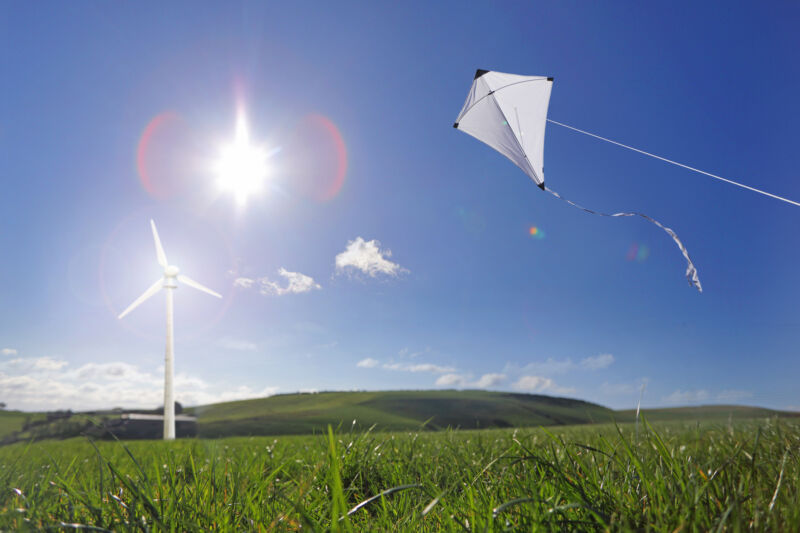
Peter Cade | Getty Images
Every kid who has ever flown a kite has learned the lesson: Once you can get the kite off the ground and high in the sky, you’re more likely to find a steady breeze to hold it up.
A fledgling wind energy industry is taking that lesson to heart. With huge kites 200 meters or more above the ground, companies use the wind they find there to generate electricity.
At least 10 firms in Europe and the United States are developing variants of this kind of kite power. If they succeed, kites could make it possible to build wind farms on land that is not windy enough for conventional wind turbine towers. Kites could also be a better choice for offshore wind power, and could one day even replace some of the anchored towers now in use.
“It’s cheaper to produce, cheaper to transport and also has higher efficiency,” said Florian Bauer, co-CEO and chief technology officer of Kitekraft, a Munich-based company developing a kite system. The ecological footprint is also much smaller, he says. “If you have all those advantages, why would anyone build a conventional wind turbine?”
But to become a widespread source of electricity, airborne wind power, as it is also known, must overcome a number of technological and commercial hurdles, as Bauer and colleagues describe in an upcoming paper in the 2022. Annual overview of control, robotics and autonomous systems† And it will have to demonstrate that it is safe, will not harm wildlife and will not cause unbearable noise and visual disturbances to neighbours.
At the moment, kite power is still in its infancy. Most companies are working on relatively small pilot projects, and none have scaled their technology to the megawatt range that would make them comparable to conventional wind turbines. But there are already small versions on the market.
In 2021, Hamburg-based SkySails Power was the first company to offer a commercial product. The production model consists of a soft, steerable kite with an area of up to 180 square meters. The kite is attached by an 800 meter long chain to a ground station in a shipping container.
In operation, the kite makes large, graceful figure-eights in the air and powers a generator on the ground that can provide an average power of 80 kilowatts — enough to power about 60 average American households. That’s small compared to a typical 2.75 megawatt wind turbine, but on par in scale with many portable industrial diesel generators. The device is designed for use in remote locations off the power grid.
Ultimately, companies want to build larger kites that can generate megawatts of power. They imagine hundreds of kites grouped at wind farms supplying electricity to the grid.
| Source | Maximum power | Number of houses that can be supplied with power |
|---|---|---|
| Existing SkySails PN-14 | 80 kW | 60 |
| Typical wind turbine | 2.75MW | 2.160 |
| Proposed commercial kite | 3.5 MW | 2,800 |
| Small Nuclear Reactor | 582 MW | 465,600 |
Using fast wind
Wind close to the ground is usually slowed down by friction with trees, buildings and hills, and the ground itself. So the higher you go, the faster the wind can travel – at 500 meters the wind moves an average of 3 to 7 kilometers per hour faster than at 100 meters. In recent decades, a number of proposals have been made to take advantage of these faster, elevated winds, including sending turbines aloft on lighter-than-aircraft or suspending them from stationary kites. But most companies, like SkySails, are pursuing an approach that uses steerable, computer-controlled kites that fly patterns in the sky to harvest more energy.
Airborne wind power systems use two basic ways to generate electricity. Ground-based approaches, such as SkySails, use “pumping power” to run a generator on the ground. The ground-based end of the cable is wrapped around a winch, and as the kite flies over the wind, it pulls against the cable and the winch unwinds, driving a generator that produces electricity. Then the kite is allowed to float while being retrieved, and the cycle begins again.
The other approach is to generate the electricity on board the kite. The onboard generation uses a rigid kite, similar to an airplane wing, that supports small wind turbines. When the kite flies, the wind spins the turbines and the electricity generated by the craft is sent through the chain to the ground station.
Kitekraft, Bauer’s company, uses the method on board, which allows it to do double use of the turbine blades. During launch and landing, the blades are powered by a motor and become propellers that allow the kite to fly and hover like a drone in the sky. Once the kite is at the right height, the turbines switch to generating energy from the wind.
Wind energy kites in the air generate electricity in two ways. “Pumping power” uses the kite’s pull to spin a rotating drum on the ground, which drives a generator (which produces electricity, yellow); when it reaches the end of the chain, the kite is retracted and starts again (uses a small amount of electricity, red). “Onboard power” is generated by turbines mounted on the kite itself. The generation on board requires a rigid kite design.

